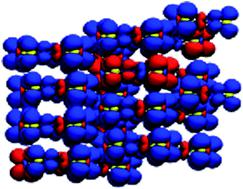当前位置:
X-MOL 学术
›
Faraday Discuss.
›
论文详情
Our official English website, www.x-mol.net, welcomes your
feedback! (Note: you will need to create a separate account there.)
Subsystem density-functional theory for interacting open-shell systems: spin densities and magnetic exchange couplings
Faraday Discussions ( IF 3.3 ) Pub Date : 2020-10-01 , DOI: 10.1039/d0fd00063a Anja Massolle 1, 2, 3, 4, 5 , Johannes Neugebauer 1, 2, 3, 4, 5
Faraday Discussions ( IF 3.3 ) Pub Date : 2020-10-01 , DOI: 10.1039/d0fd00063a Anja Massolle 1, 2, 3, 4, 5 , Johannes Neugebauer 1, 2, 3, 4, 5
Affiliation

|
We investigate the possibility of describing interacting open-shell systems in high-spin and broken-symmetry (BS) states with subsystem density-functional theory (sDFT). This subsystem method typically starts from the electronic-structure results obtained for individual systems, for which the spin states can be individually defined. Through the confining effect of the embedding potential and/or the use of monomer basis sets, these individual spin states can be preserved in sDFT calculations. This offers the possibility of easy convergence to broken-symmetry states with arbitrary local spin patterns. We show that the resulting spin densities are in very good agreement with successfully converged broken-symmetry Kohn–Sham density-functional theory (KS-DFT) calculations. Yet sDFT can even cure those BS cases where KS-DFT suffers from convergence problems or convergence to undesired spin states. In contrast to KS-DFT, the sDFT-results only show a mild exchange–correlation functional dependence. We also show that magnetic coupling constants from sDFT are not satisfactory with standard approximations for the non-additive kinetic energy. When this component is evaluated “exactly”, i.e. based on potential reconstruction, however, the magnetic coupling constants derived from spin-state energy differences are greatly improved. Hence, the interacting radicals studied here represent cases where even (semi-)local approximations for the non-additive kinetic-energy potential work well, while the parent energy functionals do not yield satisfactory results for spin-state energy differences.
中文翻译:

相互作用的开壳系统的子系统密度泛函理论:自旋密度和磁交换耦合
我们调查了用子系统密度泛函理论(sDFT)描述在高自旋和对称破坏(BS)状态下相互作用的开壳系统的可能性。该子系统方法通常从为各个系统获得的电子结构结果开始,为此可以单独定义自旋状态。通过嵌入潜能的限制效应和/或使用单体基集,可以在sDFT计算中保留这些单独的自旋态。这提供了容易收敛到具有任意局部自旋模式的对称对称状态的可能性。我们证明,所产生的自旋密度与成功收敛的破碎对称性Kohn-Sham密度泛函理论(KS-DFT)计算非常吻合。然而,sDFT甚至可以治愈那些KS-DFT遇到收敛问题或收敛到不希望的自旋状态的BS情况。与KS-DFT相比,sDFT结果仅显示出轻度的交换相关功能依赖性。我们还表明,来自sDFT的磁耦合常数对于非加成动能的标准近似值并不令人满意。当该组件被“完全”评估时,即,基于电势重构,但是,大大改善了自旋态能量差导出的磁耦合常数。因此,此处研究的相互作用自由基表示非加成动能势的偶数(半)局部近似都能很好地起作用,而母体能量泛函对于自旋态能量差没有令人满意的结果。
更新日期:2020-11-03
中文翻译:

相互作用的开壳系统的子系统密度泛函理论:自旋密度和磁交换耦合
我们调查了用子系统密度泛函理论(sDFT)描述在高自旋和对称破坏(BS)状态下相互作用的开壳系统的可能性。该子系统方法通常从为各个系统获得的电子结构结果开始,为此可以单独定义自旋状态。通过嵌入潜能的限制效应和/或使用单体基集,可以在sDFT计算中保留这些单独的自旋态。这提供了容易收敛到具有任意局部自旋模式的对称对称状态的可能性。我们证明,所产生的自旋密度与成功收敛的破碎对称性Kohn-Sham密度泛函理论(KS-DFT)计算非常吻合。然而,sDFT甚至可以治愈那些KS-DFT遇到收敛问题或收敛到不希望的自旋状态的BS情况。与KS-DFT相比,sDFT结果仅显示出轻度的交换相关功能依赖性。我们还表明,来自sDFT的磁耦合常数对于非加成动能的标准近似值并不令人满意。当该组件被“完全”评估时,即,基于电势重构,但是,大大改善了自旋态能量差导出的磁耦合常数。因此,此处研究的相互作用自由基表示非加成动能势的偶数(半)局部近似都能很好地起作用,而母体能量泛函对于自旋态能量差没有令人满意的结果。











































 京公网安备 11010802027423号
京公网安备 11010802027423号